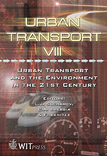Policy Options For Transport To Reduce CO2 And Tropospheric Ozone
Price
Free (open access)
Transaction
Volume
60
Pages
11
Published
2002
Size
585 kb
Paper DOI
10.2495/UT020501
Copyright
WIT Press
Author(s)
I. De Vlieger, A. Colles, J. Duerinck & S. Verbeiren
Abstract
Within the Belgian national programme ‘Sustainable Mobility’ Vito carried out a multidisciplinary study. Twelve policy options within transport were selected and evaluated on their effectivity to reduce CO2 and tropospheric ozone, and their techno-economic and social feasibility. It was found that individual policy options affect the emissions of CO2 and ozone precursors, and the ozone concentration in the atmosphere only in a small degree compared to trends set under Business-As-Usual scenario. Obviously large policy efforts are required to achieve more sustainable mobility. Although enhanced use of public transport seemed to be the most socially feasible option, this option did not fall within the best scoring options: (a) advanced introduction of environmentally friendly conventional vehicles, (b) enhanced inspection and maintenance, (c) reduced passenger car use through more car pooling and teleworking. The worst scoring options were enhanced replacement of old passenger cars and introduction of electric passenger cars.
Keywords





